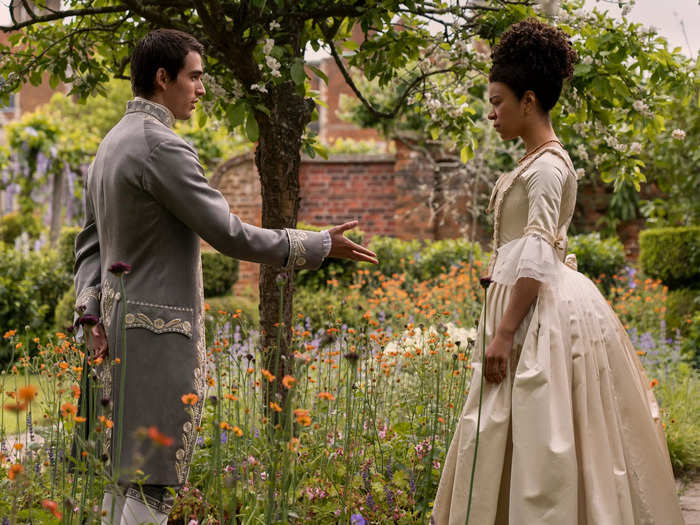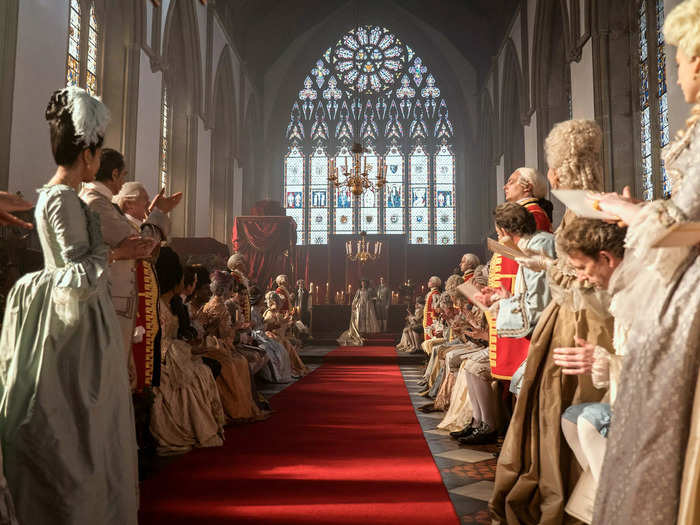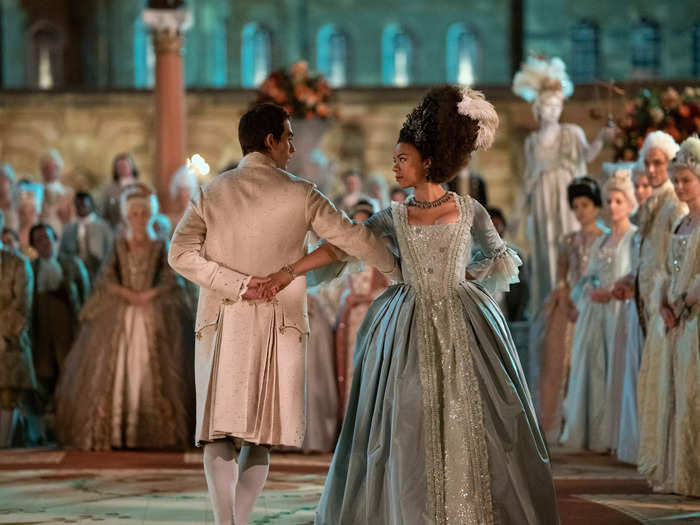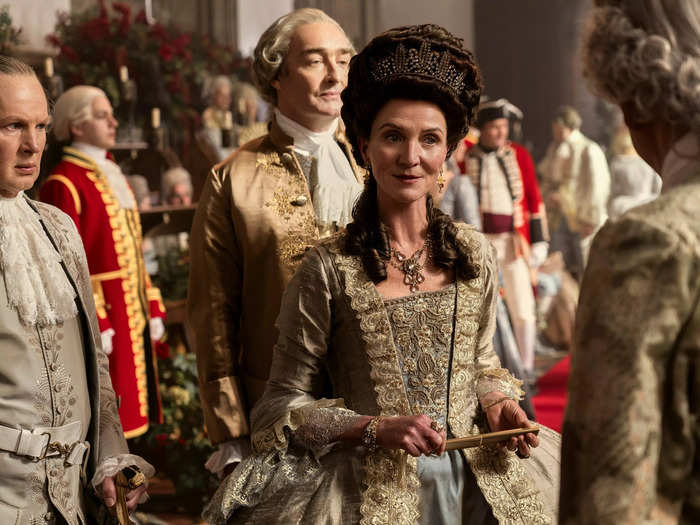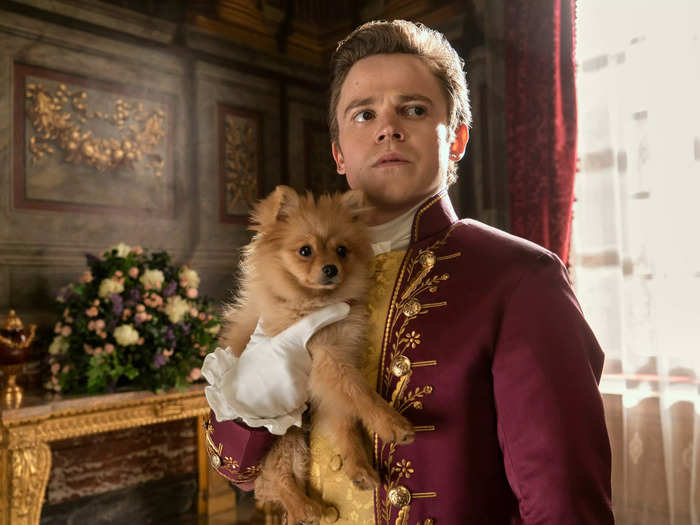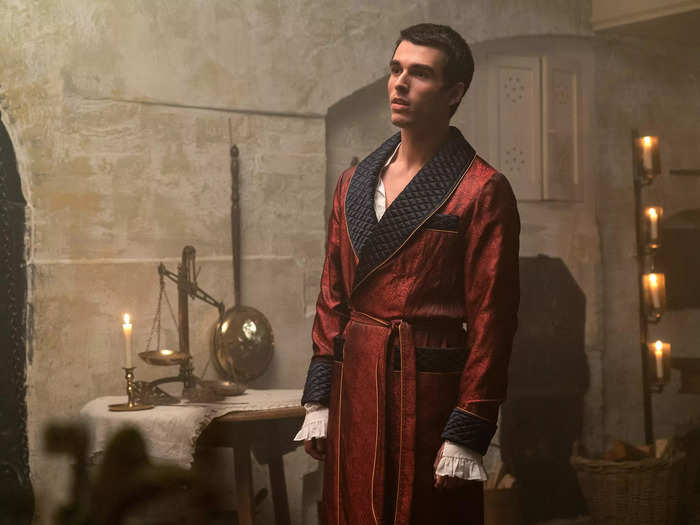India Amarteifio and Corey Mylchreest as young Queen Charlotte and young King George III.Liam Daniel / Netflix
- Netflix's "Queen Charlotte: A Bridgerton Story" premiered on Thursday.
- The "Bridgerton" spinoff is centered on the relationship between Queen Charlotte and King George III.
"Queen Charlotte: A Bridgerton Story" premiered on Netflix on May 4, enticing viewers into the glittery, romanticized reimagining of Regency-era England.
Focused mainly on the relationship between Queen Charlotte and King George III, the six-episode "Bridgerton" spinoff depicts their origin story and how they came together to reign in the UK for nearly sixty years. Given the show flashes backward and forward in time, the cast is comprised of younger and older versions of the same characters.
India Ria Amarteifio plays teenage Charlotte, while in later scenes, Golda Rosheuvel reprises her character from the main series. Meanwhile, younger George is played by Corey Mylchreest – his older counterpart is James Fleet, who has a minimal role in the "Bridgerton" spinoff.
As viewers will know, episode one of the show kicks off with a disclaimer read by narrator Lady Whistledown, voiced by Julie Andrews. She says that the story told onscreen is not a "history lesson," but simply "fiction inspired by fact." But how much of the show fact, and how much was fiction?
Take a look.
True: Charlotte and George met for the first time in a garden.
Corey Mylchreest as young King George III, India Amarteifio as young Queen Charlotte in episode one of "Queen Charlotte: A Bridgerton Story." Liam Daniel/Netflix
As the show accurately portrays, Queen Charlotte was 17 when she was betrothed to and married King George III of England.
The young royal traveled from her home country of Germany for the nuptials, which took place on September 8, 1861, at the Chapel Royal in St James's Palace.
Though the showrunners took liberties with the soon-to-be newlyweds' interaction before their wedding, it is correct that their first encounter occurred in one of the palace gardens, according to historian Olwen Hedley's biography, "Queen Charlotte."
According to primary sources cited by Hedley, Charlotte arrived at the garden gate and "threw herself" at George's feet. He subsequently "raised her up" and led her through the garden into the palace, where they tied the knot.
True: Charlotte and George got married within six hours after meeting for the first time.
Queen Charlotte and King George's wedding in episode one of "Queen Charlotte: A Bridgerton Story." Liam Daniel/Netflix
In episode one of "Queen Charlotte: A Bridgerton Story," viewers see Charlotte's journey from Germany to the UK, her quick introduction to the English court, and her speedy marriage to George.
However, how speedy her marriage was is exactly what happened in real life. Per the British royal family's website, Charlotte departed for Britain on August 17, 1961. After a lengthy and perilous journey by sea, she arrived in London on September 8. Six hours later, she was married to the king.
True: The pair had a lot of children, 15 in total.
Joshua Riley as Prince Adolphus, Harvey Almond as Prince Ernest, and Golda Rosheuvel as Queen Charlotte in episode two of "Queen Charlotte: A Bridgerton Story." Liam Daniel/Netflix
One of the lighter moments in the Netflix series has to be the interactions Golda Rosheuvel's version of Queen Charlotte has with her adult children, encouraging them to marry to ensure the continuation of their family line.
In episode one, viewers see that Charlotte has 13 surviving children. The show's number is pretty accurate as the real-life queen and king had many children together – 15 in total.
Two of their children, Prince Octavius and Prince Alfred, died from smallpox at the ages of 2 and 4 respectively, which would track with how many children were portrayed as adults in "Queen Charlotte: A Bridgerton Story," Cosmopolitan reported.
Sadly, Charlotte and George also experienced the loss of their daughter Princess Amelia, who died at age 27 from smallpox. Her death was not shown or mentioned in the series.
True: Charlotte and George shared a passion for the arts.
Corey Mylchreest as King George and India Amarteifio as Queen Charlotte in episode six of "Queen Charlotte: A Bridgerton Story." Nick Wall/Netflix
One of the first things that George tells Charlotte about himself in the "Bridgerton" spinoff is that he admires the arts. Later in the show, the couple takes part in several dances, and Charlotte is portrayed to appreciate music when she has a young Mozart play for her and her ladies-in-waiting in episode three.
And according to Historic Royal Palaces, the royal couple's love of the arts, music, and dance is all true. They would frequent theatres, watch plays and concerts, and even spend time together playing musical instruments such as the harpsichord and flute.
What's more, Charlotte did actually meet and have a young Wolfgang Amadeus Mozart play for her. According to The Royal Collection Trust, when he was 8 years old, Mozart visited the UK and performed for the royals in 1764. Later in life, he dedicated six sonatas to Charlotte.
False: George had little say in choosing Charlotte as his bride.
Richard Cunningham as Lord Bute, Neil Edmond as Earl Harcourt, and Michelle Fairley as Princess Augusta in episode one of "Queen Charlotte: A Bridgerton Story." Liam Daniel/Netflix
In the show, George's mother, Princess Augusta, and her courtiers are portrayed as the ones behind finding him a bride and organizing the wedding. In episode four, which flashes back to George's perspective of the first episode, he is told by his valet, Reynolds, that his mother found him a bride.
Contrary to the show, George was actively part of the search for his wife. According to historian Catherine Curzon's piece for History Extra, George picked Charlotte specifically because she was a good royal and was, more importantly, protestant. He also liked that she was said to be amenable.
False: George gifted Charlotte her first Pomeranian.
Sam Clemmett as young Brimsley in episode two of "Queen Charlotte: A Bridgerton Story." Liam Daniel/Netflix
After their wedding in the show, Charlotte and George's relationship takes a turn for the worst. Amid the tension and physical separation, with George living at one royal residence and Charlotte at another, he sends her a gesture in the form of a Pomeranian puppy, which she calls a "deformed bunny."
However, Charlotte was already the proud owner of multiple Pomeranians before she married George, Harper's Bazaar reported. The publication notes that Charlotte brought two Pomeranians, Phoebe, and Mercury, with her when she first sailed to the UK and eventually gifted others she bred to her royal relatives.
False: George experienced his first bout of mental illness prior to marrying Charlotte.
Corey Mylchreest as young King George in episode four of "Queen Charlotte: A Bridgerton Story." Liam Daniel/Netflix
In the series, George's hesitation toward marrying Charlotte was based mainly on the fact that he was worried about how his mental state would affect their marriage. In episode four, when told by his mother that a marriage to a German princess had been put together on his behalf, he appears to start suffering a mental break. At the time of his wedding, George was just 22 years old.
That timeline does not coincide with what historical health records of the king shared by the National Library of Medicine. According to the NLM, George suffered mental health issues when he was 27 but remained generally healthy until he experienced a severe psychotic illness in 1789 when he was 50.
As Insider's Claudia Willen and Ayomikun Adekaiyero previously reported, there have been multiple theories surrounding George's mental condition since he died in 1820. One theory that arose in recent years was that he suffered from porphyria, a genetic blood disorder that can cause confusion, hallucinations, and paranoia.
Meanwhile, after analyzing his journals, other historians have theorized that the king had a mental illness, per History.com. In 2013, the BBC reported that one study based at St George's, University of London, found that the monarch's letters had similar symptoms to patients experiencing the manic phase of psychiatric illnesses like bipolar disorder.

